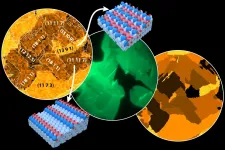INFORMATION:
Titles and links:
Time course of phosphorylated-tau181 in blood across the Alzheimer's disease spectrum, https://doi.org/10.1093/brain/awaa399
Diagnostic performance and prediction of clinical progression of plasma phospho-tau181 in the Alzheimer's Disease Neuroimaging Initiative, https://doi.org/10.1038/s41380-020-00923-z
Longitudinal Associations of Blood Phosphorylated Tau181 and Neurofilament Light Chain With Neurodegeneration in Alzheimer Disease, https://jamanetwork.com/journals/jamaneurology/fullarticle/2774467
Contacts:
Kaj Blennow, kaj.blennow@neuro.gu.se, +46 761 07 38 35
Michael Schöll, michael.scholl@neuro.gu.se, +46 705 72 74 71
Henrik Zetterberg, henrik.zetterberg@clinchem.gu.se, +46 768 67 26 47
New studies support blood test for early detection of Alzheimer's disease
2021-01-13
(Press-News.org) In three recent publications in Molecular Psychiatry, Brain and JAMA Neurology researchers from the University of Gothenburg provide convincing evidence that an in-house developed blood test for Alzheimer's disease can detect the disease early and track its course, which has major implications for a potential use in clinical practice and treatment trials.
"This is an extremely dynamic research field right now, thanks to the technological development and seminal scientific progress in the past years. The dream scenario is to have a blood test for the early detection and screening of Alzheimer's disease up and running. That would give significantly more people in the world access to testing and future treatments", says Michael Schöll, associate professor and one of the senior authors.
After decades of research, we now know that Alzheimer's disease-related memory problems are just the tip of the iceberg of underlying degenerative processes in the brain that have been silently developing over years or even decades.
These processes result from abnormal aggregation of amyloid and tau proteins in the brain, with these aggregates being the defining pathological features of Alzheimer's disease. Until recently, it was only possible to detect these protein aggregates in the brains of deceased patients at autopsy.
Recent research advances, however, have enabled the accurate detection of amyloid and tau pathology in the brain with imaging methods and in the cerebrospinal fluid of living individuals. These current so-called biomarker methods are either expensive, invasive, or only available at specialized centers; thus, only a fraction of patients suffering from the disease currently benefit from these advances.
An accessible, affordable, and minimally invasive biomarker for Alzheimer's disease would revolutionize care of patients worldwide, as well as boost the development of novel drugs for this presently still incurable disease.
In 2020, researchers at Sahlgrenska Academy, University of Gothenburg, have discovered such a biomarker: a cheap blood test capable to detect the presence of phosphorylated tau protein (p-tau181), a principal, defining hallmark of Alzheimer's disease. Three recent scientific articles from the same study group now focus on the diagnostic performance of this blood marker and how it changes over time during healthy aging and during disease.
The authors demonstrated great potential for the blood test to predict and monitor Alzheimer's disease progression in an unprecedently large study comprising more than 1100 subjects from the Alzheimer's Disease Neuroimage Initiative (ADNI), followed up over several years.
First authors are Thomas Karikari (the article in Molecular Psychiatry) and Alexis Moscoso (Brain and JAMA Neurology).
"The recent development of blood tests sensitive to Alzheimer's disease pathology is likely to provide a solution and has the potential to significantly change the way this disease can be managed in the near future", Moscoso says.
In the publication in Brain the researchers analyzed participants' blood samples acquired at different ages to construct the temporal trajectory of p-tau181 levels in blood across the long course of Alzheimer's disease.
Importantly, they found that the novel blood test could detect abnormalities in p-tau181 levels several years before the onset of memory loss, suggesting enormous potential for early disease detection.
This potential was further confirmed in another publication in Molecular Psychiatry, with first author Thomas Karikari, in which the investigators demonstrated the high clinical utility of p-tau181 in blood for predicting future Alzheimer's disease dementia, even among individuals who had not experienced any memory impairment in the moment of the blood test.
Finally, in the third and most recent publication in JAMA Neurology, the scientists demonstrated that annual increases of p-tau181 in blood were strongly coupled to the loss of nerve cells in Alzheimer's disease as well as to cognitive decline, suggesting not only potential for prediction but also for monitoring and identifying rapidly progressive forms of the disease in an affordable yet effective way. Professor Henrik Zetterberg:
"Our findings have clear and novel implications for the use of these tests, both as diagnostic tools, but also as outcome measures in clinical trials, as we showed that the levels of phosphorylated p-tau181 and Neurofilament light, NfL, in standard blood samples, are reliable biomarkers for Alzheimer's disease, specifically p-tau181, and for neurodegenerative diseases in general, NfL."
Together, these studies represent a crucial step towards the widespread use of biomarkers in clinical routine, making effective blood biomarker testing for Alzheimer's disease a reality for most clinical settings, including primary care. Professor Kaj Blennow:
"This is a major step forward showing that blood tests for tau pathology and neurodegeneration have clinical value to track disease progression in patients with Alzheimer's disease", he says.
ELSE PRESS RELEASES FROM THIS DATE:
Workaholism leads to mental and physical health problems
2021-01-13
Workaholism or work addiction risk is a growing public health concern that can lead to many negative mental and physical health outcomes such as depression, anxiety or sleep disorder. Perception of work (job demands and job control) may become a major cause of employees' work addiction. The international group of researchers including the HSE University scientist explored the link between work addiction risk and health-related outcomes using the framework of Job Demand Control Model. The results were published in the International Journal of Environmental Research and Public Health.
Workaholics are people who usually work seven and more hours more than ...
High-sensitivity nanophotonic sensors with passive trapping of analyte molecules in hot-spots
2021-01-13
Optical sensors can quantitatively analyze chemical and biological samples by measuring and processing the optical signals produced by the samples. Optical sensors based on infrared absorption spectroscopy can achieve high sensitivity and selectivity in real time, and therefore play a crucial role in a variety of application areas such as environmental sensing, medical diagnostics, industrial process control and homeland security.
In a new paper published in Light: Science & Applications, a team of scientists, led by Dr. Peter Q. Liu from the Department of Electrical Engineering, the State University of New York at Buffalo, have demonstrated a new type of high-performance optical sensor which can utilize ...
Catalysts: worth taking a closer look
2021-01-13
Metal surfaces play a role as catalysts for many important applications - from fuel cells to the purification of car exhaust gases. However, their behaviour is decisively affected by oxygen atoms incorporated into the surface.
This phenomenon has been known for a long time, but until now it has not been possible to precisely investigate the role of oxygen in complex surfaces point by point in order to understand the chemical background at the atomic level. This has now been achieved at TU Wien in cooperation with a team from the Elettra Synchrotron in Trieste. It became possible ...
Could we harness energy from black holes?
2021-01-13
A remarkable prediction of Einstein's theory of general relativity--the theory that connects space, time, and gravity--is that rotating black holes have enormous amounts of energy available to be tapped.
For the last 50 years, scientists have tried to come up with methods to unleash this power. Nobel physicist Roger Penrose theorized that a particle disintegration could draw energy from a black hole; Stephen Hawking proposed that black holes could release energy through quantum mechanical emission; while Roger Blandford and Roman Znajek suggested electromagnetic ...
UCI scientists measure local vibrational modes at individual crystalline faults
2021-01-13
Irvine, Calif., Jan. 11, 2021 - Often admired for their flawless appearance to the naked eye, crystals can have defects at the nanometer scale, and these imperfections may affect the thermal and heat transport properties of crystalline materials used in a variety of high-technology devices.
Employing newly developed electron microscopy techniques, researchers at the University of California, Irvine and other institutions have, for the first time, measured the spectra of phonons - quantum mechanical vibrations in a lattice - at individual crystalline faults, and they discovered the propagation of phonons near the flaws. The team's findings are the subject of a study published recently in Nature.
"Point defects, dislocations, stacking ...
UCI researchers use deep learning to identify gene regulation at single-cell level
2021-01-13
Irvine, Calif., Jan. 5, 2021 -- Scientists at the University of California, Irvine have developed a new deep-learning framework that predicts gene regulation at the single-cell level.
Deep learning, a family of machine-learning methods based on artificial neural networks, has revolutionized applications such as image interpretation, natural language processing and autonomous driving. In a study published recently in Science Advances, UCI researchers describe how the technique can also be successfully used to observe gene regulation at the cellular level. Until now, that process had ...
Research reveals how teeth functioned and evolved in giant mega-sharks
2021-01-13
A pioneering study by University of Bristol researchers finds that the evolution of teeth in the giant prehistoric shark Megalodon and its relatives was a by-product of becoming huge, rather than an adaptation to new feeding habits.
The iconic extinct Megalodon was the largest shark to ever roam the seas. Its name translates to 'big tooth', making reference to its massive teeth, which represent the most abundant fossil remains of the species. They are broad and triangular, nothing like the curved, blade-like teeth of the closest relatives of Megalodon.
The ...
Recurrent GBM brain tumors with few mutations respond best to immunotherapy
2021-01-13
DURHAM, N.C. - Glioblastoma brain tumors are especially perplexing. Inevitably lethal, the tumors occasionally respond to new immunotherapies after they've grown back, enabling up to 20% of patients to live well beyond predicted survival times.
What causes this effect has long been the pursuit of researchers hoping to harness immunotherapies to extend more lives.
New insights from a team led by Duke's Preston Robert Tisch Brain Tumor Center provide potential answers. The team found that recurring glioblastoma tumors with very few mutations are far more vulnerable ...
Upper ocean temperatures hit record high in 2020
2021-01-13
Even with the COVID-19-related small dip in global carbon emissions due to limited travel and other activities, the ocean temperatures continued a trend of breaking records in 2020. A new study, authored by 20 scientists from 13 institutes around the world, reported the highest ocean temperatures since 1955 from surface level to a depth of 2,000 meters.
The report was published on January 13 in Advances in Atmospheric Sciences and concluded with a plea to the policymakers and others to consider the lasting damage warmer oceans can cause as they attempt to mitigate the ...
Ukraine genome survey adds missing pieces to human diversity puzzle
2021-01-13
Today, the largest study of genetic diversity in Ukraine was published in the open science journal GigaScience. The project was an international effort, bringing together researchers in Ukraine, the US and China and is the first fruits of this collaboration to set up a new Central Europe Center for Genomic Research in Ukraine. Led by researchers at Uzhhorod National University and Oakland University in the US, the work provides genetic understanding of the historic and pre-historic migration settlements in one of the key intersections of human trade and migration between the Eurasian peoples as well as the identification of genetic variants of medical interest in the Ukrainian population that differ ...






